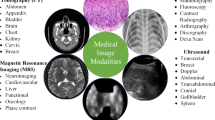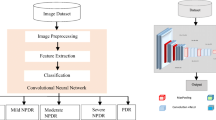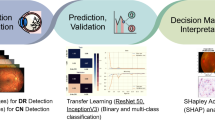Abstract
Diabetic retinopathy (DR) is a human eye disease in which the eye’s retina is damaged in diabetics. Diabetic retinopathy can be diagnosed by manually interpreting retinal fundus images, even though that takes longer to diagnose. Among these, the most challenging task in diagnosing the DR disease is edge detection in retinal fundus images to identify the region of infection and its severity. This paper aims to use the adaptive neural network-based Laplacian of Gaussian (AnLoG) classification algorithm on features extracted from diverse retinal fundus images to improve DR disease diagnostic accuracy and reduce training time. Based on the retinal fundus image in the Messidor dataset, the consequence of the proposed AnLoG classification algorithm for detecting diabetic retinopathy is compared to traditional supervised BPN machine learning algorithms and other contemporary techniques. AnLoG has proved its supremacy in terms of accuracy (97.29%), recall (94.64%), precision (93.13%), and F-Score (93.80%). Simulation results show that the proposed technique performs well compared to the existing approach.







Similar content being viewed by others
Data availability
The datasets used and/or analysed during the current study are available from the corresponding author on reasonable request.
References
Steinmetz JD et al (2021) Causes of blindness and vision impairment in 2020 and trends over 30 years, and prevalence of avoidable blindness in relation to VISION 2020: the Right to Sight: an analysis for the Global Burden of Disease Study. Lancet Glob Heal 9(2):e144–e160. https://doi.org/10.1016/S2214-109X(20)30489-7
East M, Africa N (2017) IDF diabetes atlas. Diabetes 20:79
Fong DS et al (2004) Retinopathy in diabetes. Diabetes Care 27(suppl_1):s84–s87. https://doi.org/10.2337/diacare.27.2007.S84
Krishnasamy L, Tamilselvi A, Dhanaraj RK (2022) An innovative outcome of internet of things and artificial intelligence in remote centered healthcare application schemes. In: Healthcare 4.0. Chapman and Hall/CRC, Boca Raton, pp 245–265
Huang S, Li J, Xiao Y, Shen N, Xu T (2022) RTNet: relation transformer network for diabetic retinopathy multi-lesion segmentation. IEEE Trans Med Imaging 41(6):1596–1607. https://doi.org/10.1109/TMI.2022.3143833
Das D, Biswas SK, Bandyopadhyay S (2022) A critical review on diagnosis of diabetic retinopathy using machine learning and deep learning. Multimed Tools Appl 81(18):25613–25655. https://doi.org/10.1007/s11042-022-12642-4
Rajesh E et al (2022) Machine learning for online automatic prediction of common disease attributes using never-ending image learner. Diagnostics 13(1):95. https://doi.org/10.3390/diagnostics13010095
Atwany MZ, Sahyoun AH, Yaqub M (2022) Deep learning techniques for diabetic retinopathy classification: a survey. IEEE Access 10:28642–28655. https://doi.org/10.1109/ACCESS.2022.3157632
Gundluru N et al (2022) Enhancement of detection of diabetic retinopathy using Harris hawks optimization with deep learning model. Comput Intell Neurosci 2022:1–13. https://doi.org/10.1155/2022/8512469
Devi RM et al (2021) Detection of diabetic retinopathy using optimized back-propagation neural network (Op-BPN) algorithm. In: 2021 5th International conference on computing methodologies and communication (ICCMC), pp 1695–1699. https://doi.org/10.1109/ICCMC51019.2021.9418433
Sudha V, Ganesh Babu TR, Vikram N, Raja R (2021) Comparison of detection and classification of hard exudates using artificial neural system vs. SVM radial basis function in diabetic retinopathy. Mol Cell Biomech 18(3):139–145. https://doi.org/10.32604/mcb.2021.016056
Subhramaniyan T, Suruthi S, Paulraj MS, Ragunathan MG, Jayanthi J (2021) A study on finding the most prevalent age groups of diabetic retinopathy among diabetic population using fuzzy matrix theory. J Phys Conf Ser 1979(1):012022. https://doi.org/10.1088/1742-6596/1979/1/012022
Aamir KM, Sarfraz L, Ramzan M, Bilal M, Shafi J, Attique M (2021) A fuzzy rule-based system for classification of diabetes. Sensors 21(23):8095. https://doi.org/10.3390/s21238095
Ghoushchi SJ, Ranjbarzadeh R, Dadkhah AH, Pourasad Y, Bendechache M (2021) An extended approach to predict retinopathy in diabetic patients using the genetic algorithm and Fuzzy C-means. Biomed Res Int 2021:1–13. https://doi.org/10.1155/2021/5597222
Kumar G, Chatterjee S, Chattopadhyay C (2021) DRISTI: a hybrid deep neural network for diabetic retinopathy diagnosis. Signal Image Video Process 15(8):1679–1686. https://doi.org/10.1007/s11760-021-01904-7
Jayanthi J, Jayasankar T, Krishnaraj N, Prakash NB, Sagai Francis Britto A, Vinoth-Kumar K (2021) An intelligent particle swarm optimization with convolutional neural network for diabetic retinopathy classification model. J Med Imaging Heal Inform 11(3):803–809. https://doi.org/10.1166/jmihi.2021.3362
Saeed F, Hussain M, Aboalsamh HA (2021) Automatic diabetic retinopathy diagnosis using adaptive fine-tuned convolutional neural network. IEEE Access 9:41344–41359. https://doi.org/10.1109/ACCESS.2021.3065273
Hemanth DJ, Deperlioglu O, Kose U (2020) An enhanced diabetic retinopathy detection and classification approach using deep convolutional neural network. Neural Comput Appl 32(3):707–721. https://doi.org/10.1007/s00521-018-03974-0
Shankar K, Sait ARW, Gupta D, Lakshmanaprabu SK, Khanna A, Pandey HM (2020) Automated detection and classification of fundus diabetic retinopathy images using synergic deep learning model. Pattern Recognit Lett 133:210–216. https://doi.org/10.1016/j.patrec.2020.02.026
Antal B, Hajdu A (2012) An ensemble-based system for microaneurysm detection and diabetic retinopathy grading. IEEE Trans Biomed Eng 59(6):1720–1726. https://doi.org/10.1109/TBME.2012.2193126
Shankar K, Perumal E, Vidhyavathi RM (2020) Deep neural network with moth search optimization algorithm based detection and classification of diabetic retinopathy images. SN Appl Sci 2(4):748. https://doi.org/10.1007/s42452-020-2568-8
Yaqoob MK, Ali SF, Bilal M, Hanif MS, Al-Saggaf UM (2021) ResNet based deep features and random forest classifier for diabetic retinopathy detection. Sensors 21(11):3883. https://doi.org/10.3390/s21113883
Priya R, Sivarani T, Saravanan A (2021) <scp>Deep</scp> long and short term memory based Red Fox optimization algorithm for diabetic retinopathy detection and classification. Int J Numer Methods Biomed Eng. https://doi.org/10.1002/cnm.3560
Erciyas A, Barışçı N (2021) An effective method for detecting and classifying diabetic retinopathy lesions based on deep learning. Comput Math Methods Med 2021:1–13. https://doi.org/10.1155/2021/9928899
Acharya UR, Ng EYK, Tan J-H, Sree SV, Ng K-H (2012) An integrated index for the identification of diabetic retinopathy stages using texture parameters. J Med Syst 36(3):2011–2020. https://doi.org/10.1007/s10916-011-9663-8
Stitt AW et al (2016) The progress in understanding and treatment of diabetic retinopathy. Prog Retin Eye Res 51:156–186. https://doi.org/10.1016/j.preteyeres.2015.08.001
Ghosal SK, Mandal JK, Sarkar R (2018) High payload image steganography based on Laplacian of Gaussian (LoG) edge detector. Multimed Tools Appl 77(23):30403–30418. https://doi.org/10.1007/s11042-018-6126-y
Manjula Devi R, Kuppuswami S, Suganthe RC (2013) Fast linear adaptive skipping training algorithm for training artificial neural network. Math Probl Eng 2013, https://doi.org/10.1155/2013/346949
Decencière E et al (2014) Feedback on a publicly distributed image database: the messidor database. Image Anal Stereol 33(3):231. https://doi.org/10.5566/ias.1155
Messidor Dataset. https://www.adcis.net/en/third-party/messidor/
Subramaniam K, Palanisamy N, Sinnaswamy RA, Muthusamy S, Mishra OP, Loganathan AK et al (2023) A comprehensive review of analyzing the chest X-ray images to detect COVID-19 infections using deep learning techniques. Soft Comput 1–22
Thangavel K, Palanisamy N, Muthusamy S, Mishra OP, Sundararajan SCM, Panchal H et al (2023) A novel method for image captioning using multimodal feature fusion employing mask RNN and LSTM models. Soft Comput 1–14
Krishnasamy KG, Periasamy S, Periasamy K, Prasanna Moorthy V, Thangavel G, Lamba R, Muthusamy S (2023) A pair-task heuristic for scheduling tasks in heterogeneous multi-cloud environment. Wirel Pers Commun 1–32
Gnanadesigan NS, Dhanasegar N, Ramasamy MD, Muthusamy S, Mishra OP, Pugalendhi GK et al (2023) An integrated network topology and deep learning model for prediction of Alzheimer disease candidate genes. Soft Comput 1–15
Rakkiannan T, Ekambaram G, Palanisamy N, Ramasamy RR, Muthusamy S, Loganathan AK et al (2023) An automated network slicing at edge with software defined networking and network function virtualization: a federated learning approach. Wirel Pers Commun 1–20
Periyasamy K, Rathinam V, Ganesan K, Ramachandran M, Muthusamy S, Lamba R et al (2023) A novel method for analyzing the performance of free space optical communication in WDM using EDFA. Wirel Pers Commun 1–29
Batcha BBC, Singaravelu R, Ramachandran M, Muthusamy S, Panchal H, Thangaraj K, Ravindaran A (2023) A novel security algorithm RPBB31 for securing the social media analyzed data using machine learning algorithms. Wirel Pers Commun 1–28
Haghighi S, Jasemi M, Hessabi S, Zolanvari A (2018) PyCM: multiclass confusion matrix library in Python. J Open Source Softw 3(25):729. https://doi.org/10.21105/joss.00729
Kong X, Hu C, Duan Z (2017) Principal component analysis networks and algorithms. Springer, Singapore
Artasanchez A, Joshi P (2020) Artificial intelligence with python: your complete guide to building intelligent apps using Python 3. x. Packt Publishing Ltd (2020)
Acknowledgements
This work was supported by Qatar National Research Fund under the Grant No. MME03-1226-210042. The statements made herein are solely the responsibility of the authors.
Author information
Authors and Affiliations
Corresponding author
Ethics declarations
Conflict of interest
The authors declare that they have no conflict of interest.
Additional information
Publisher’s Note
Springer Nature remains neutral with regard to jurisdictional claims in published maps and institutional affiliations.
Rights and permissions
Springer Nature or its licensor (e.g. a society or other partner) holds exclusive rights to this article under a publishing agreement with the author(s) or other rightsholder(s); author self-archiving of the accepted manuscript version of this article is solely governed by the terms of such publishing agreement and applicable law.
About this article
Cite this article
Ramasamy, M.D., Periasamy, K., Periasamy, S. et al. A novel Adaptive Neural Network-Based Laplacian of Gaussian (AnLoG) classification algorithm for detecting diabetic retinopathy with colour retinal fundus images. Neural Comput & Applic 36, 3513–3524 (2024). https://doi.org/10.1007/s00521-023-09324-z
Received:
Accepted:
Published:
Issue Date:
DOI: https://doi.org/10.1007/s00521-023-09324-z




